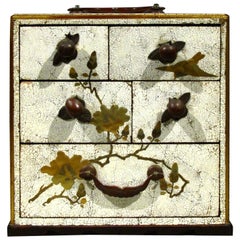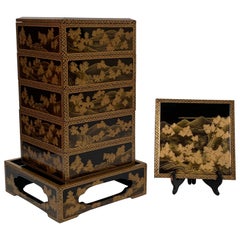Lacquer
Lacquer For Sale
Color: White
Signed Japanese White Lacquer and Maki-E Lacquer Tansu, Meiji Period
Located in Ottawa, Ontario
The case decorated overall in crackle-glaze white lacquer and fitted with a patinated metal carrying handle over three tiers of small drawers. The first two tiers are comprised of a ...
Category
Late 19th Century Japanese Meiji Antique Lacquer
Materials
Lacquer
Related Items
Japanese Maki-e Lacquer Stacking Box, Jubako, Meiji Period, Japan
Located in Austin, TX
A fine and impressive Japanese gold maki-e decorated black lacquer five-tier jubako with presentation tray, two lids, and the original tomobako storage box, Meiji period, late 19th c...
Category
Late 19th Century Japanese Meiji Antique Lacquer
Materials
Lacquer
Signed Mid 19th C. Edo/Meiji Period Miniature Lacquer Stacking Cabinet, Japan
Located in Oxfordshire, United Kingdom
The highly decorated tray in the form of a table frames a series of three stacking boxes, a further three lidded boxes and a tray concealed within, raised on ogee bracket feet.
This...
Category
19th Century Japanese Meiji Antique Lacquer
Materials
Lacquer
Free Shipping
H 4.89 in W 5.12 in D 3.51 in
Japanese Marquetry and Lacquer Jewelry Chest, Meiji Period, circa 1900, Japan
Located in Austin, TX
A very attractive Japanese wood table top jewelry or collector's chest with marquetry and lacquer decoration, Meiji period, circa 1900, Japan. Previously in the collection of Asbjorn Lunde (1927 - 2017).
The chest is crafted in the form of a Chinese seal...
Category
Early 1900s Japanese Meiji Antique Lacquer
Materials
Wood, Softwood, Lacquer
H 15.75 in W 14.25 in D 7 in
Japanese Lacquered Box Signed, Late 19th Century
Located in Beuzevillette, FR
Pretty Japanese lacquered box decorated with birds and foliage.
signed
Lacquered inside and outside
Late 19th century
Without key
Nice lock
Ideal for storing jewelry.
Category
Late 19th Century Japanese Antique Lacquer
Materials
Wood
Antique Japanese Dramatically Carved and Lacquered Stack Box on Stand
Located in Hudson, NY
Antique Japanese dramatically carved and lacquered stack box on stand. Meiji period (1868 - 1912) lacquer stacking box, traditionally used for bringing mochi (rice cake) to celebrati...
Category
Late 19th Century Japanese Meiji Antique Lacquer
Materials
Lacquer
Japanese Lacquer Box with Fine Maki-e Decoration Meiji Period
Located in Atlanta, GA
A lacquered wood box with lid from Japan circa 19th century Meiji Period. The finely decorated box was used to store paper slips and small documents on the desk. It is overall finished with black lacquer (kuro) with sparse Mura-Nashiji effect outside and on the top surface of the lid, there are three Komainu, (sometimes known as Shishi or Japanese lions) frolicking and forming a circle in lively motion. Komainu are auspicious animals in Japanese cultures in both Shinto and Buddhism tradition. Originally from China, these animals symbolizes guardians to ward off evil spirits. Hiramaki-e was used in combination with carving and combing to render the lions with various surface textures. A gilt border with an slight angle was given to the lid and even the thin band is decorated with miniature floral scrolls. The interior of the box was finished in a dense nashiji. Underneath the lid, a cluster of peonies open lavishly by two gentle mounts. Takamaki-e (high relief) in both gold and silver were...
Category
Late 19th Century Japanese Japonisme Antique Lacquer
Materials
Wood, Lacquer
Japanese Laquered Box with Hinged Lid hand painted, 19th Century Meiji Period
Located in Lincoln, Lincolnshire
This is a good papier mâché, rectangular shaped black lacquered lidded box, hand enamelled and gilded, made in Japan during the 19th century, early Meiji period.
This rectangular shaped papier mâché box has a well fitting hinged lid, with the box base and lid slightly domed. The box was probably originally made as a pocket box but could easily sit on a desk or dressing table as required.
This is a very decorative box with finely hand painted scenes of three people, one holding a parasol, in a garden setting, with a pagoda type building, large gate...
Category
19th Century Japanese Meiji Antique Lacquer
Materials
Paper
H 1.38 in W 3 in D 2.13 in
Japanese Laquered Tray Decorated with People on a Verandah, Meiji Period
Located in Lincoln, Lincolnshire
This is a good papier mâché, circular, black lacquered tray, hand enameled and gilded, made in Japan during the 19th century, Meiji period.
This circular tray is very decorative, ...
Category
19th Century Japanese Meiji Antique Lacquer
Materials
Paper
Japanese Maki-e Lacquer Stack Box Jubako
Located in Atlanta, GA
An antique jubako (stack boxes) with five tiers in an elongated octagon shape circa 19th century (end of Edo or beginning of Meiji period). jubako was traditionally used to store and...
Category
19th Century Japanese Japonisme Antique Lacquer
Materials
Wood, Lacquer
Japanese Lacquer House Shaped Incense Box, Kogo, Meiji Period, Japan
Located in Austin, TX
A delightful and intricately decorated lacquer box for storing incense, kogo, in the form of a traditional farm house, Meiji period (1864 - 1912), late 19th century, Japan.
The kogo, or small box for storing incense, takes the whimsical form of a traditional Japanese home, minka, with the removable high, thatched roof serving as the cover for the box.
The exterior of the home has been painstakingly decorated in maki-e lacquer against a matte black lacquer ground. Traditional shoji doors, bamboo blinds...
Category
Late 19th Century Japanese Meiji Antique Lacquer
Materials
Lacquer
Free Shipping
H 2.75 in W 3 in D 2.5 in
Rare Japanese Sumi-E Lacquer Inro Yamada Jokasai Edo Period
Located in Atlanta, GA
A three-case lacquered Inro by Yamada Family circa 18th-19th century Edo period. The inro with slight rounded form is of Kano style and vividly depicts a dragon slithering among the ink clouds on a gold background. Sumi-e togidashi (ink togidashi) technique, in combination with Hiramaki-e, were employed to create the dreamy ambience of this piece. The dragon has a painterly appearance inspired by Chinese ink painting that was often seen on the Japanese folding screens. The back of the Inro was sparsely decorated with the shifting patterns of the darkening clouds with an emphasis on the space intentionally left empty. Jokasai was signed to the base. On the front of the inro there is another miniature signature Hakugyoku Hogen, which is one of names used by Kano Michinobu (1730-1790). The dragon is evidently one of his designs (see reference below).
Established by a member of Yamada family in the 17th century, the clan was one of the most prominent lacquer artisanal family for the next 200 years until the end of Edo period in the 19th century. Most members signed their work simply with Jokasai making the identification of the individual artists somewhat impossible. The current Inro on offer, compared to many other pieces by Jokasai, has an uncommon Kano style done in Sumi-e togidashi.
Another unusual feature of this piece is that the interiors of the inro was decorated with an interesting gold mosaic inlays (kirigane) on a dark lacquer background, giving it a jewel like quality.
For another Inro by Jokasai of a similar style using Sumi-e togidashi but depicts a tiger, see Wrangham collection, no.353, which was offered for sale as lot 256 in Bonham's London Auction: The Edward Wrangham Collection of Japanese Art Part I. 9 Nov 2010.
For an ink scroll...
Category
18th Century Japanese Japonisme Antique Lacquer
Materials
Wood, Lacquer
Japanese Rinpa Style Lacquer Box Meiji Period
Located in Atlanta, GA
A black lacquer tebako (hand box) with maki-e decoration and silver trim, circa late 19th century, Meiji period. The surface of the lid features a Rinpa style maki-e paint depicting ...
Category
1890s Japanese Japonisme Antique Lacquer
Materials
Wood, Lacquer
Recently Viewed
View AllMore Ways To Browse
Maki E
Antique Japanese Lacquer Tray
Japanese Lacquer Tray Antique
Antique Chinese Cinnabar
Black Lacquer Asian Floral
Vintage Japanese Lacquer
Red Lacquer Cinnabar
Lacquer Ware
Asian Small Lacquer Box
Japanese Family Crest
Japanese Black Lacquer Tray
Black Cinnabar
Kyoto Lacquer
Japanese Mother Of Pearl Art
Chinese Carved Cinnabar
Burmese Red Lacquered
Japanese Pearl Inlay
Large Japanese Tray


